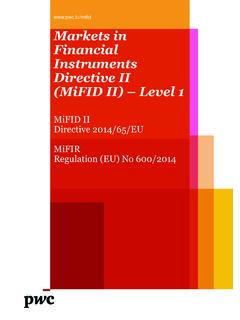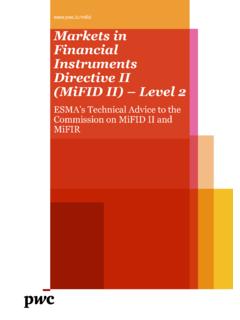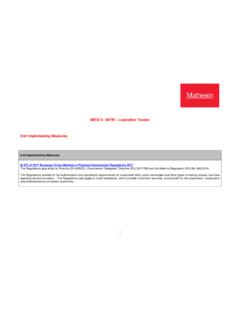Transcription of MiFID II: The New Transparency Regime - CENCOR
1 March 2014. MiFID II: The New Transparency Regime Overview Contents The overhaul of the Markets in financial instruments directive ( MiFID ) that Overview .. 1. was agreed by European legislators on 14 January 2014 includes sweeping changes to the pre- and post-trade Transparency Regime for EU financial 1. markets. The current requirements under MiFID , which are limited to shares Impact on equity markets . 2. admitted to trading on regulated markets, will be extended to cover other Impact on non-equity equity-like and non-equity instruments traded on any trading venue, including markets .. 2. multilateral trading facilities ( MTFs ) and the new category of organised Availability and access.
2 3. trading facilities ( OTFs ). Systematic internalisers ( SIs ) and other investment firms that trade over-the-counter in financial instruments will also Impact on systematic internalisers and investment be subject to expanded pre- and post-trade Transparency obligations. A. firms .. 4. framework has been introduced for trade data to be published through Consolidated tape .. 4. approved arrangements and made available via a consolidated tape. The transaction reporting obligations of MiFID have also been expanded, though What happens next? .. 5. these are beyond the scope of this note. Contacts .. 6. The revised Transparency Regime is primarily contained in a new Regulation ( MiFIR ) which, together with a new directive ( MiFID II ), will replace the existing MiFID .
3 As a regulation, MiFIR will have direct effect in all EU Member States, while MiFID II will require transposition into national law. The new legislation must now be formally adopted by the European Parliament and the Council of the European Union, and will not be implemented until late 2016 at the earliest. Many details of the new Transparency requirements will be set out in Level 2. acts consisting of regulatory technical standards ( RTS ) and delegated acts. The RTS will be drafted by the European Securities and Markets Authority ( ESMA ) and adopted by the European Commission, while the Commission will draft the delegated acts, with advice from ESMA.
4 It is expected that ESMA will launch a public consultation in the coming months so that market participants can comment on the substance of these measures. Background MiFID , which entered into force in November 2007, established a harmonised regulatory framework for the provision of investment services and the operation of regulated markets across the European Union. Among other things, it sought to make the financial markets more transparent and to level the playing field between trading venues. MiFID II: The New Transparency Regime The Commission's proposals arose out of a review in which the Commission had identified a number of issues with the existing Regime .
5 market fragmentation made the collection of trade data more complex. A significant amount of bonds and derivative instruments were traded outside organised venues, hindering price discovery. The Commission concluded that changes were needed to increase Transparency and create a more level playing field. While the final legislation largely follows the Commission's recommendations, a number of significant changes have been introduced. Impact on equity markets The existing pre- and post- trade Transparency requirements will be extended to cover shares and other equity-like instruments such as depositary receipts, exchange-traded funds and certificates that are traded on regulated markets, MTFs and OTFs.
6 Pre-trade Transparency requirements will be calibrated for different types of trading systems including order-book, quote-driven, hybrid, and periodic auction trading systems. ESMA will specify in RTS the scope of pre-trade information to be made public. Competent authorities will continue to be able to waive pre-trade Transparency obligations in certain cases such as for orders that are large in scale. The reference price waiver, which the Commission had deleted in its proposal, has been retained for equity instruments , and a negotiated price waiver added. Order management waivers will also be available. However, the volume that can be traded on dark pools under the reference price waiver and the negotiated price waiver will be capped at 4% per trading venue and 8% overall across the EU.
7 How this will work in practice is unclear, particularly in the absence of a consolidated tape. Details of the different types of waivers and the volume cap mechanism will be clarified in RTS. A competent authority wishing to waive pre-trade Transparency will need to notify other competent authorities as well as ESMA, which will issue a non- binding opinion on whether the waiver complies with the requirements of MiFIR. If another competent authority disagrees with a waiver, ESMA will help mediate a solution and could order a waiver to be withdrawn. As is currently the case for shares, the publication of post-trade information may be deferred for equity instruments in some cases.
8 ESMA may mediate disputes between the competent authorities of different Member States regarding the authorisation of deferred publication. The scope and timing of post-trade Transparency , as well as the conditions for deferral, will be detailed in RTS. Impact on non-equity markets MiFIR will introduce a new pre- and post-trade Transparency Regime for bonds, structured finance products, emissions allowances and derivatives traded on regulated markets, MTFs and OTFs. As with equities, the requirements will be the same regardless of trading venue, though pre-trade MiFID II: The New Transparency Regime 2. Transparency requirements will be calibrated for different types of trading systems including order-book, quote-driven, hybrid, and periodic auction trading systems.
9 Pre-trade Transparency for non-equity instruments will also be calibrated for voice trading systems. Waivers relating to pre-trade Transparency will be available for large-in-scale orders and orders held pending disclosure, actionable indications of interest in request-for-quote and voice trading systems above a specified size that would expose liquidity providers to undue risk, derivatives not subject to the trading obligation, and other financial instruments for which there is no liquid market . If a waiver is granted, indicative pre-trade bid and offer prices must be published continuously during trading hours. Derivative transactions of non- financial counterparties entered into for hedging purposes will be exempt from pre-trade Transparency together.
10 Member State regulators may withdraw waivers for non-equity instruments in certain circumstances. Regulators may also temporarily suspend pre-trade Transparency requirements for non-equity instruments if liquidity falls below a specified threshold. The scope of pre-trade information to be made public, and details of the different types of waivers, will be clarified in RTS, as will the methods and parameters for calculating the liquidity threshold. As with equities, ESMA and other competent authorities will need to be informed of any waivers, and ESMA will issue an opinion and mediate any disputes between authorities. ESMA must also be notified of any suspension of obligations by competent authorities.

![g^ÔfYf[aYd afkljme]flkak egj][gehd]p& …](/cache/preview/b/5/9/1/d/b/b/8/thumb-b591dbb864bb015fedab5e78503dfa32.jpg)




